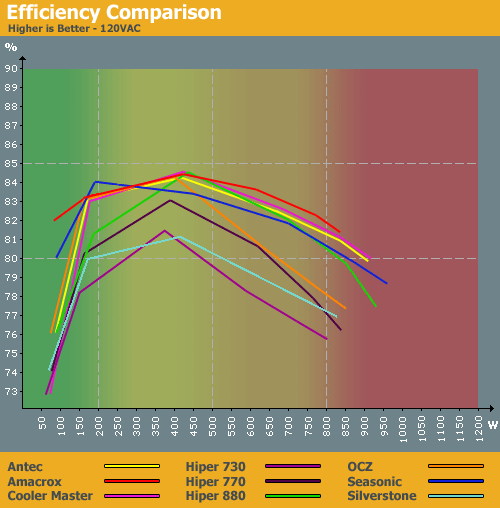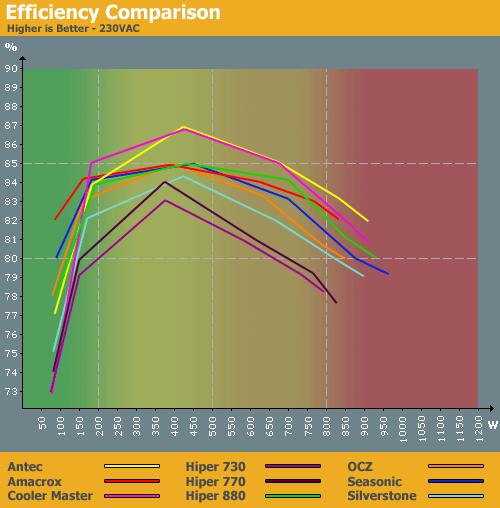Power Supply Roundup: 730W to 900W
by Christoph Katzer on November 22, 2007 3:00 AM EST- Posted in
- Cases/Cooling/PSUs
Product Comparison - Efficiency
We have color-coded the background graphic to represent four classes of PSU. Category one is in the green and represents small to medium systems with a single lower power graphics card. The yellow range is for systems with a single graphics card, though possibly one of the more demanding models, as well as systems with a more powerful CPU (quad-core) and potentially more than one hard drive. The orange background is for systems with two graphics cards, possibly with a quad-core processor as well. Finally, we have the red category which is frankly very difficult to reach with normal home computers at the moment; serious overclocking, quad-core, and multiple GPUs can require this sort of power supply. This background will be used in future comparisons as well, and with the wattage figures as the X axis users will be better able to choose a power supply that offers high efficiency in the desired range.


Obviously, if you are running a normal setup with a single graphics card you will not need any of the units we're testing today. If you are using a typical dual-core CPU with a moderate graphics card (without overclocking), you will not need a power supply with more than 400W max output. Your system will likely draw 75W-125W in idle mode (perhaps slightly less), and with higher-end power supplies like what we're testing today you would get a relatively low efficiency rating. Only systems that are regularly using more than 200W should even consider these 730W and higher power supplies.
The two units with the best efficiency results today are the Antec and Cooler Master models, which are both manufactured by the same ODM. Many of the other models show similar results, reaching near 85% efficiency. The OCZ ModXStream 850W and the Hiper 730W and 770W take the bottom three curves at 120VAC; the Silverstone unit is also near the bottom on the 230VAC chart.










31 Comments
View All Comments
engman - Wednesday, January 23, 2008 - link
Can you explain beter the Voltage Ripple and Noise graphs?I really cant get it! Where is the graph scale?
engman - Wednesday, January 23, 2008 - link
I was trying to find a good PSU and found this review.When you say: "The actual Power Supply Design Guide specifies that each +12V rail should not have any ripple over 120mV and the +3.3V and +5V rails should not have any ripple over ~50mV."
Means that each power rail should not go outside this interval:
11.88V < 12V < 12.12V 120mV
3.25V < 3.30V < 3.35V 50mV
4.95V < 5V < 5.05V 50mV
Correct?
How can 12.17V fall inside the specified range? "The 12V rails of the OCZ ModXStream tended to be high, but this is still acceptable as they fall inside the specified range."
4.75V is inside the specs? and 5.13?
"The 5V rails also remain within specs, but the last two units (OCZ and Amacrox) are very close to the lower boundary at 100% load."
So what are the exac boundaries, or the voltage interval for each power rail?
thanks
yelnatsch517 - Thursday, December 6, 2007 - link
I noticed the Cooler Master reviewed was the M850 ESBA modular version of the RS 850 EMBA. Seeing as how it is impossible to find that model in the US, I am wondering if the model reviewed was either a EU version or a new model Cooler Master is planning on introducing in the near future and also whether the internals of the US EMBA 850watt version are the same.jonnyGURU - Friday, December 14, 2007 - link
The Cooler Masters are identical. Cooler Master refrains from selling the modular version in the U.S. due to Ultra's patent on the modular interface and threats to sue. You CAN buy the Cooler Master modular here in the U.S. if you get it bundled with a case. I've seen it pre-installed in some Stacker units over at Newegg.stolennomenclature - Tuesday, December 4, 2007 - link
I know im getting old and the old brain isnt what it used to be, but did'nt i read somewhere about dwindling oil reserves, skyrocketing oil prices, depletion of the ozone layer, and the need to reduce energy counsumption and be the green movement? I even thought I saw a trend with cpu makers trying to lower energy counsmption of their cpu's.You would'nt think any of this stuff was real when you see the trend towards bigger fuel guzzling SUV's and now a article like this - why on earth do we need kilowatt power supplies for a PC!
If I was in government id have these things banned or else slap an enormous tax on them.
People need to wake up and smell the roses. Its obscene that a PC should need a power supply over 300 watts. Even thats extravagant.
jonnyGURU - Friday, December 14, 2007 - link
A PSU only puts out what's asked of it. So if you're PC only uses 300W, the PSU only puts out 300W. Really the only drawback here is that larger units typically cost more to buy, and neither you nor I are in the position to tell someone how to spend their money. ;)ShadowStryder - Monday, November 26, 2007 - link
Persoanally I like the new review layout.Toadster - Saturday, November 24, 2007 - link
850W of goodness for under $190http://www.newegg.com/Product/Product.aspx?Item=N8...">http://www.newegg.com/Product/Product.a...=N82E168...
recently was on sale for $119 A/R
HexiumVII - Friday, November 23, 2007 - link
Who manufactures the Antec 750?Christoph Katzer - Saturday, November 24, 2007 - link
The 850? Enhance.